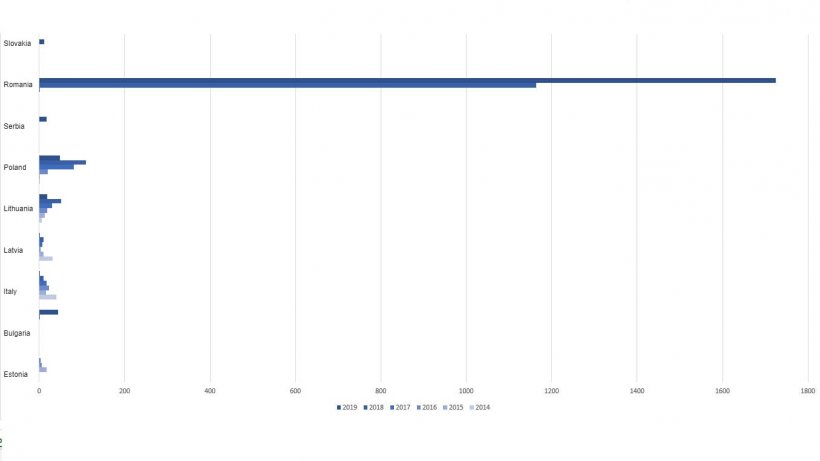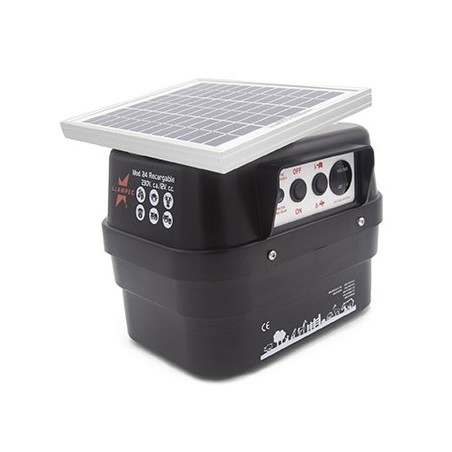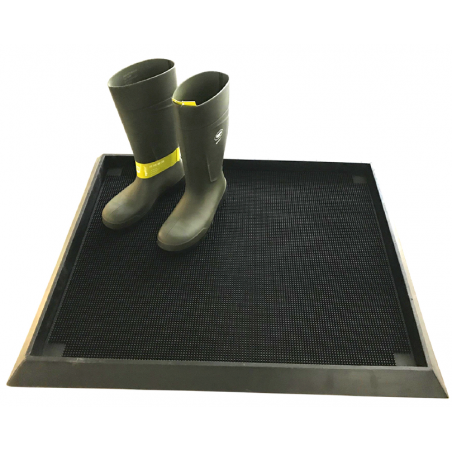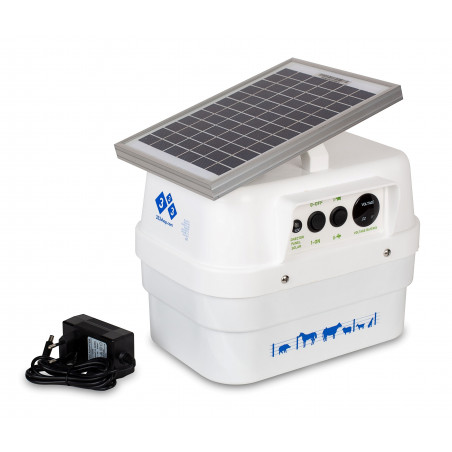According to ADNS data, ASF cases continued to increase in EU countries during the past year, with 11 member states now affected (including Italy where ASF is endemic and only has infected the island of Sardinia). In 2019 the disease appeared for the first time in Slovakia and Serbia.
During the past year, the number of confirmed cases increased both in wild boar (6,396 cases verses 5,362 in 2018) and in domestic pigs (1,866 outbreaks verses 1,344 in 2018).


ASF cases in wild boar in 2019.

ASF outbreaks in domestic pigs in the EU for 2019.
Belgium ended the year with 482 cases in wild boar, and has seen no new cases since the summer. In October and December, cases were detected in deceased wild boar, the remains of which were analyzed, determining that the boar had been dead for at least three months, putting the time of death prior to September 2019, according to specialists.
Bulgaria confirmed its first case of ASF in August 2018, involving domestic pigs. After that first outbreak up until July 2019, only cases in wild boar had occurred. However, since the second ASF outbreak in domestic pigs at the beginning of July, cases have escalated quickly and new outbreaks have occurred, bringing the total number of outbreaks in domestic pigs to 44 and in wild boar to 165.
The Czech Republic reported the disease for the first time in 2017 in wild boar, with no occurrences in domestic pigs. The Czech Republic stands out due to its successful eradication of the disease, as no new cases have been seen since April 2018.
Slovakia, free of the disease up until last year, confirmed its first outbreak in July on a backyard farm located near the Hungarian and Ukrainian borders, both countries affected by the disease. By the end of the year, Slovakia had confirmed 48 cases in wild boar and 11 in domestic pigs.
In Estonia, where the disease appeared in 2014, cases have decreased dramatically in both domestic pigs and wild boar. In 2019, 80 cases in wild boar were confirmed. No cases in domestic pigs have been reported since 2018.
| No. of outbreaks | Domestic/Wild hogs 2014 |
Domestic/Wild hogs 2015 |
Domestic/Wild hogs 2016 |
Domestic/Wild hogs 2017 |
Domestic/Wild hogs 2018 |
Domestic/Wild hogs 2019 |
|---|---|---|---|---|---|---|
| Poland | 2/24 | 1/52 | 20/80 | 81/741 | 109/2443 | 48/2468 |
| Latvia | 32/148 | 10/752 | 3/864 | 8/947 | 10/685 | 1/369 |
| Lithuania | 6/45 | 13/111 | 19/303 | 30/1.328 | 51/1446 | 19/464 |
| Estonia | 0/41 | 18/723 | 6/1052 | 3/637 | 0/231 | 0/80 |
| Czech Republic | 0/0 | 0/0 | 0/0 | 0/202 | 0/28 | 0/0 |
| Romania | 0/0 | 0/0 | 0/0 | 2/0 | 1164/182 | 1724/683 |
| Hungary | 0/0 | 0/0 | 0/0 | 0/0 | 0/138 | 0/1598 |
| Bulgaria | 0/0 | 0/0 | 0/0 | 0/0 | 1/5 | 44/165 |
| Belgium | 0/0 | 0/0 | 0/0 | 0/0 | 0/163 | 0/482 |
| Slovakia | 0/0 | 0/0 | 0/0 | 0/0 | 0/0 | 11/27 |
| Serbia | 0/0 | 0/0 | 0/0 | 0/0 | 0/0 | 18/0 |
Hungary reported the first case of ASF in April 2018. Although its domestic herd remains free of the disease, it has shown a significant increase in cases in wild boar, from 182 between April and December 2018 to 1,598 in 2019.
Latvia has seen decreased cases in both domestic pigs and wild boar. In wild boar, the number of confirmed cases was half that of the previous year (685 vs. 369). Regarding the presence of the disease in domestic pigs, during the past year a single outbreak was confirmed in July on a farm with 52 susceptible animals.
Lithuania, having had cases in wild boar and domestic pigs since 2014, has seen a significant reduction in the number of cases in wild boar, from 1,143 in 2018 to 464 in 2019. The disease has been spreading from the east of the country to the west since its initial confirmation. During 2019, no cases were confirmed prior to June, but since then 19 cases have been confirmed.
With regard to Poland, in addition to the significant number of outbreaks detected, what stood out was that the disease took a geographical leap last November, when cases were confirmed in wild boar in Lubuskie, some 300 km away from the nearest existing outbreaks, some of these outbreaks located less than 20 km from the German boarder. The disease then spread to Wielkopolskim, the area in Poland with the highest pig production.
Romania stands out as the member state with the highest number of outbreaks in domestic pigs in 2019, with a total of 1724 outbreaks, some of them on large farms; and 683 cases in wild boar. According to information from the National Sanitary Veterinary Authority, to date 545,000 affected pigs have been culled since the first outbreak.
Serbia, which had previously remained free of the disease, confirmed its first case in backyard pigs in August of last year and ended 2019 with 18 outbreaks in domestic pigs and no cases in wild boar. However, on Friday, January 17, 2020, the OIE reported the first cases in wild boar- 7 animals in Borski, near the Romanian border and in Pirotski, near Bulgaria.
January 23, 2020/ Publication by 333 with information from the Animal Disease Notification System of the European Union.













